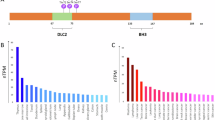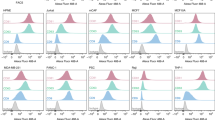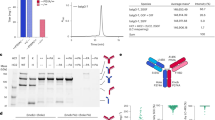Abstract
All BH3-only proteins, key initiators of programmed cell death, interact tightly with multiple binding partners and have sequences of low complexity, properties that are the hallmark of intrinsically unstructured proteins (IUPs). We show, using spectroscopic methods, that the BH3-only proteins Bim, Bad and Bmf are unstructured in the absence of binding partners. Detailed sequence analyses are consistent with this observation and suggest that most BH3-only proteins are unstructured. When Bim binds and inactivates prosurvival proteins, most residues remain disordered, only the BH3 element becomes structured, and the short α-helical molecular recognition element can be considered to behave as a ‘bead on a string’. Coupled folding and binding is typical of many IUPs that have important signaling roles, such as BH3-only proteins, as the inherent structural plasticity favors interaction with multiple targets. This understanding offers promise for the development of BH3 mimetics, as multiple modes of binding are tolerated.
Similar content being viewed by others
Log in or create a free account to read this content
Gain free access to this article, as well as selected content from this journal and more on nature.com
or
Abbreviations
- BH:
-
Bcl-2 homology
- CDF:
-
cumulative distribution frequency
- IUP:
-
intrinsically unstructured protein
- TM:
-
transmembrane
- HSQC:
-
heteronuclear single quantum coherence
References
Cory S, Huang DC, Adams JM . The Bcl-2 family: roles in cell survival and oncogenesis. Oncogene 2003; 22: 8590–8607.
Puthalakath H, Strasser A . Keeping killers on a tight leash: transcriptional and post-translational control of the pro-apoptotic activity of BH3-only proteins. Cell Death Differ 2002; 9: 505–512.
Hinds MG, Day CL . Regulation of apoptosis: uncovering the binding determinants. Curr Opin Struct Biol 2005; 15: 690–699.
Sattler M, Liang H, Nettesheim D, Meadows RP, Harlan JE, Eberstadt M et al. Structure of Bcl-xL-Bak peptide complex: recognition between regulators of apoptosis. Science 1997; 275: 983–986.
Petros AM, Nettesheim DG, Wang Y, Olejniczak ET, Meadows RP, Mack J et al. Rationale for Bcl-xL/Bad peptide complex formation from structure, mutagenesis, and biophysical studies. Protein Sci 2000; 9: 2528–2534.
Liu X, Dai S, Zhu Y, Marrack P, Kappler JW . The structure of a Bcl-xL/Bim fragment complex: implications for Bim function. Immunity 2003; 19: 341–352.
Yan N, Gu L, Kokel D, Chai J, Li W, Han A et al. Structural, biochemical, and functional analyses of CED-9 recognition by the proapoptotic proteins EGL-1 and CED-4. Mol Cell 2004; 15: 999–1006.
Chen L, Willis SN, Wei A, Smith BJ, Fletcher JI, Hinds MG et al. Differential targeting of prosurvival Bcl-2 proteins by their BH3-only ligands allows complementary apoptotic function. Mol Cell 2005; 17: 393–403.
McDonnell JM, Fushman D, Milliman CL, Korsmeyer SJ, Cowburn D . Solution structure of the proapoptotic molecule BID: a structural basis for apoptotic agonists and antagonists. Cell 1999; 96: 625–634.
Chou JJ, Li H, Salvesen GS, Yuan J, Wagner G . Solution structure of BID, an intracellular amplifier of apoptotic signaling. Cell 1999; 96: 615–624.
Aouacheria A, Brunet F, Gouy M . Phylogenomics of life-or-death switches in multicellular animals: Bcl-2, BH3-only and BNIP families of apoptotic regulators. Mol Biol Evol 2005; 22: 2395–2416.
Dyson HJ, Wright PE . Intrinsically unstructured proteins and their functions. Nat Rev Mol Cell Biol 2005; 6: 197–208.
Dunker AK, Cortese MS, Romero P, Iakoucheva LM, Uversky VN . Flexible nets. The roles of intrinsic disorder in protein interaction networks. FEBS J 2005; 272: 5129–5148.
Adachi M, Zhao X, Imai K . Nomenclature of dynein light chain-linked BH3-only protein Bim isoforms. Cell Death Differ 2005; 12: 192–193.
O'Connor L, Strasser A, O'Reilly LA, Hausmann G, Adams JM, Cory S et al. Bim: A novel member of the Bcl-2 family that promotes apoptosis. EMBO J 1998; 17: 384–395.
Ley R, Ewings KE, Hadfield K, Cook SJ . Regulatory phosphorylation of Bim: sorting out the ERK from the JNK. Cell Death Differ 2005; 12: 1008–1014.
Puthalakath H, Huang DC, O'Reilly LA, King SM, Strasser A . The proapoptotic activity of the Bcl-2 family member Bim is regulated by interaction with the dynein motor complex. Mol Cell 1999; 3: 287–296.
Akiyama T, Bouillet P, Miyazaki T, Kadono Y, Chikuda H, Chung UI et al. Regulation of osteoclast apoptosis by ubiquitylation of proapoptotic BH3-only Bcl-2 family member Bim. EMBO J 2003; 22: 6653–6664.
Fan J, Zhang Q, Tochio H, Li M, Zhang M . Structural basis of diverse sequence-dependent target recognition by the 8 kda dynein light chain. J Mol Biol 2001; 306: 97–108.
Uversky VN, Gillespie JR, Fink AL . Why are ‘natively unfolded’ proteins unstructured under physiologic conditions? Proteins 2000; 41: 415–427.
Oldfield CJ, Cheng Y, Cortese MS, Brown CJ, Uversky VN, Dunker AK . Comparing and combining predictors of mostly disordered proteins. Biochemistry 2005; 44: 1989–2000.
Oldfield CJ, Ulrich EL, Cheng Y, Dunker AK, Markley JL . Addressing the intrinsic disorder bottleneck in structural proteomics. Proteins 2005; 59: 444–453.
Linding R, Jensen LJ, Diella F, Bork P, Gibson TJ, Russell RB . Protein disorder prediction: implications for structural proteomics. Structure 2003; 11: 1453–1459.
Iakoucheva LM, Radivojac P, Brown CJ, O'Connor TR, Sikes JG, Obradovic Z et al. The importance of intrinsic disorder for protein phosphorylation. Nucleic Acids Res 2004; 32: 1037–1049.
Singh GP, Ganapathi M, Sandhu KS, Dash D . Intrinsic unstructuredness and abundance of PEST motifs in eukaryotic proteomes. Proteins 2006; 62: 309–315.
Bourhis JM, Johansson K, Receveur-Brechot V, Oldfield CJ, Dunker KA, Canard B et al. The C-terminal domain of measles virus nucleoprotein belongs to the class of intrinsically disordered proteins that fold upon binding to their physiological partner. Virus Res 2004; 99: 157–167.
Bienkiewicz EA, Adkins JN, Lumb KJ . Functional consequences of preorganized helical structure in the intrinsically disordered cell-cycle inhibitor p27(KIP1). Biochemistry 2002; 41: 752–759.
Dyson HJ, Wright PE . Insights into the structure and dynamics of unfolded proteins from nuclear magnetic resonance. Adv Protein Chem 2002; 62: 311–340.
Wilson-Annan J, O'Reilly LA, Crawford SA, Hausmann G, Beaumont JG, Parma LP et al. Proapoptotic BH3-only proteins trigger membrane integration of prosurvival Bcl-w and neutralize its activity. J Cell Biol 2003; 162: 877–887.
Hinds MG, Lackmann M, Skea GL, Harrison PJ, Huang DC, Day CL . The structure of Bcl-w reveals a role for the C-terminal residues in modulating biological activity. EMBO J 2003; 22: 1497–1507.
Denisov AY, Chen G, Sprules T, Moldoveanu T, Beauparlant P, Gehring K . Structural model of the Bcl-w-Bid peptide complex and its interactions with phospholipid micelles. Biochemistry 2006; 45: 2250–2256.
Whitmore L, Wallace BA . DICHROWEB, an online server for protein secondary structure analyses from circular dichroism spectroscopic data. Nucleic Acids Res 2004; 32: W668–W673.
Iakoucheva LM, Brown CJ, Lawson JD, Obradovic Z, Dunker AK . Intrinsic disorder in cell-signaling and cancer-associated proteins. J Mol Biol 2002; 323: 573–584.
Oldfield CJ, Cheng Y, Cortese MS, Romero P, Uversky VN, Dunker AK . Coupled folding and binding with alpha-helix-forming molecular recognition elements. Biochemistry 2005; 44: 12454–12470.
Day CL, Puthalakath H, Skea G, Strasser A, Barsukov I, Lian LY et al. Localization of dynein light chains 1 and 2 and their pro-apoptotic ligands. Biochem J 2004; 377: 597–605.
Gunasekaran K, Tsai CJ, Kumar S, Zanuy D, Nussinov R . Extended disordered proteins: targeting function with less scaffold. Trends Biochem Sci 2003; 28: 81–85.
Lee JW, Soung YH, Kim SY, Nam SW, Kim CJ, Cho YG et al. Inactivating mutations of proapoptotic Bad gene in human colon cancers. Carcinogenesis 2004; 25: 1371–1376.
Conradt B, Horvitz HR . The C. elegans protein EGL-1 is required for programmed cell death and interacts with the Bcl-2-like protein CED-9. Cell 1998; 93: 519–529.
Prakash S, Tian L, Ratliff KS, Lehotzky RE, Matouschek A . An unstructured initiation site is required for efficient proteasome-mediated degradation. Nat Struct Mol Biol 2004; 11: 830–837.
Day CL, Chen L, Richardson SJ, Harrison PJ, Huang DC, Hinds MG . Solution structure of prosurvival Mcl-1 and characterization of its binding by proapoptotic BH3-only ligands. J Biol Chem 2005; 280: 4738–4744.
Schuck P . Size-distribution analysis of macromolecules by sedimentation velocity ultracentrifugation and lamm equation modeling. Biophys J 2000; 78: 1606–1619.
Acknowledgements
We thank Bronwyn Carlisle for help with preparing the figures. Our research is supported by the Marsden Fund (NZ), Leukemia and Lymphoma Society (Specialized Centre for Research 7015-02), Australian NH&MRC (Program Grant 257502) and fellowship (DCSH) and US NCI (CA 80188).
Author information
Authors and Affiliations
Corresponding author
Additional information
Edited by JC Martinou
Rights and permissions
About this article
Cite this article
Hinds, M., Smits, C., Fredericks-Short, R. et al. Bim, Bad and Bmf: intrinsically unstructured BH3-only proteins that undergo a localized conformational change upon binding to prosurvival Bcl-2 targets. Cell Death Differ 14, 128–136 (2007). https://doi.org/10.1038/sj.cdd.4401934
Received:
Revised:
Accepted:
Published:
Issue date:
DOI: https://doi.org/10.1038/sj.cdd.4401934
Keywords
This article is cited by
-
Non-canonical phosphorylation of Bmf by p38 MAPK promotes its apoptotic activity in anoikis
Cell Death & Differentiation (2022)
-
A Novel Anti-CD22 scFv.Bim Fusion Protein Effectively Induces Apoptosis in Malignant B cells and Promotes Cytotoxicity
Applied Biochemistry and Biotechnology (2022)
-
Stepwise activation of the pro-apoptotic protein Bid at mitochondrial membranes
Cell Death & Differentiation (2021)
-
The pro-apoptotic domain of BIM protein forms toxic amyloid fibrils
Cellular and Molecular Life Sciences (2021)
-
A computationally designed chimeric antigen receptor provides a small-molecule safety switch for T-cell therapy
Nature Biotechnology (2020)



